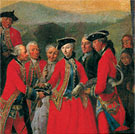|
||||||||||||||||
|
|
||||||||||||||||
|

Humans, Nature and Birds |
From Room 5: Birds and Promoting Conservation |
||||
|
|||||
 Plate 35 |
|
two phoebes near Philadelphia bearing the silver cord he had tied to their legs the previous year, when they were still in their nest. (The banded nestling phoebes—called Peewee Flycatchers in Audubon’s day—became special friends of Audubon’s; he frequently visited them while courting Lucy Bakewell, later his wife.) These isolated incidents were among the first faltering steps toward using a monitoring technique that took a century to catch on but eventually became a worldwide activity. Today thousands of serious students of bird biology participate in banding, and it contributes substantially to our knowledge about birds.[77] |
|||
Plates 35 and 35a. Untitled [The banding of a heron] and detail, probably 1764, by an unknown artist |
|||||